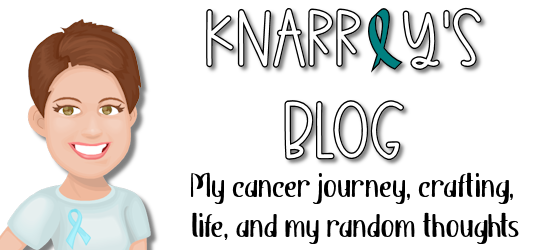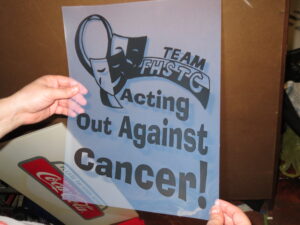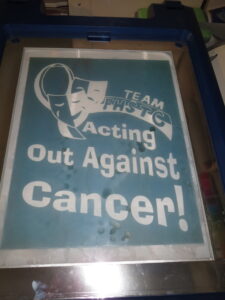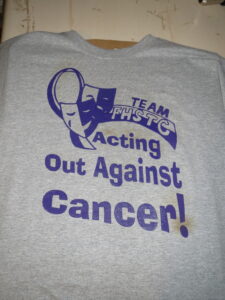Next in my (much delayed) Relay For Life crafting series is screen printing. My daughter and son’s Relay team wanted to make their own shirts for the day of event. We had previously designed a screen, but we needed to make it bigger. (Which ended up with us getting a wide format printer to print bigger transparencies and posters.) Since we were essentially starting over, my son, Buddy, decided to draw the new logo. After printing it on the transparency, it looked like this:
The design was a hit. He made the ribbon and mask merge himself, and we digitized it and added the “acting out against cancer” part later. For those not familiar with screen printing, it needs to be printed on a transparency. The Yudu machine then has a lightbox, and it exposes light on the emulsified screen. The light shines through the transparent part of the design, and the emulsion hardens on these spots. The black/dark section does not harden because the light is blocked. This part (the design) washes out with a sprayer in a sink or shower, and becomes the stencil. Here is the finished and dried screen:
And here is the t-shirt, on the platen:
I opted in this case to use plastisol based ink (purple, for Relay!) The typical Yudu inks are water based. They are easy to clean up and easy to work with. But, they are not opaque. So they print well on white or light colors but do not show so well on darker colors. I ordered the purple plastisol ink online from the Screen Printing Superstore. It is very hard to wash out, both out of the screen and off your hands. (Note to readers: I found an easy to obtain solution to remove the ink from the screen: Goo Gone! My latest bottles came with spray applicators, and it removes the ink wonderfully without buying expensive online screen openers.) And the ink does not dry on it’s own. That is actually a good and a bad thing. It is good, because the ink can stay on the screen longer. Water based ink will damage the screen if it dries, while the plastisol can be flooded on the screen if you need time to cure ink before printing another shirt. But, it is bad in the sense that the ink MUST be heat cured to dry. This makes it difficult to remove the shirt from the sticky platen to put it on a heat safe surface. But the results ARE worth it! I also prefer to use a wooden handled squeegee instead of Yudu’s squeegee. (See here.)
And here is a finished shirt on Sierra:
**The image in this post was lost during the blog redesign.**
Happy Crafting!



